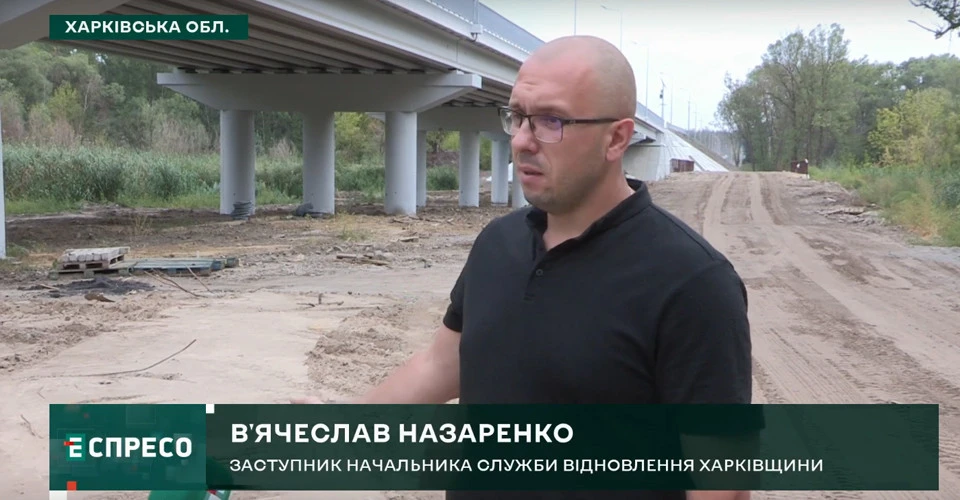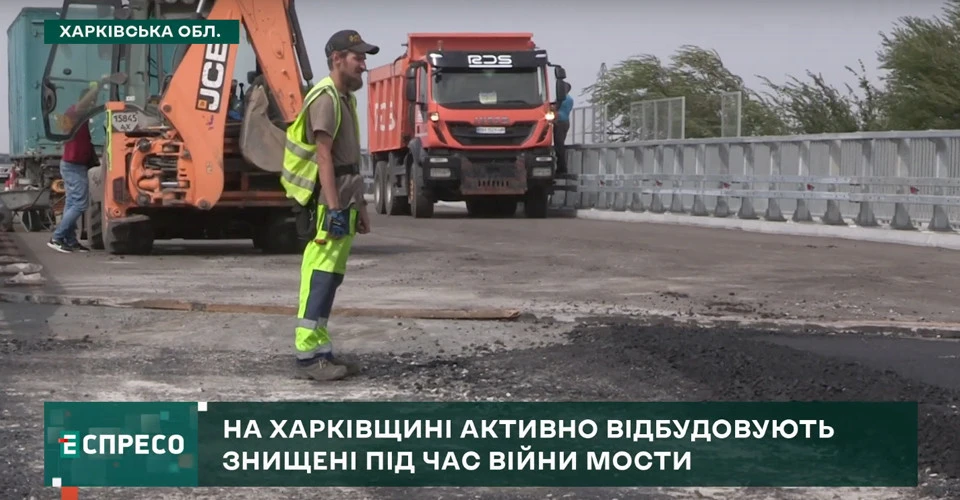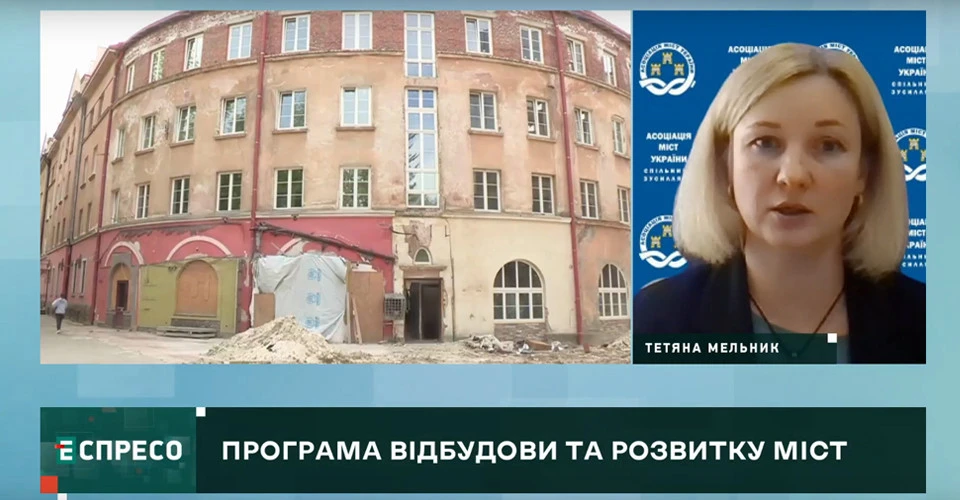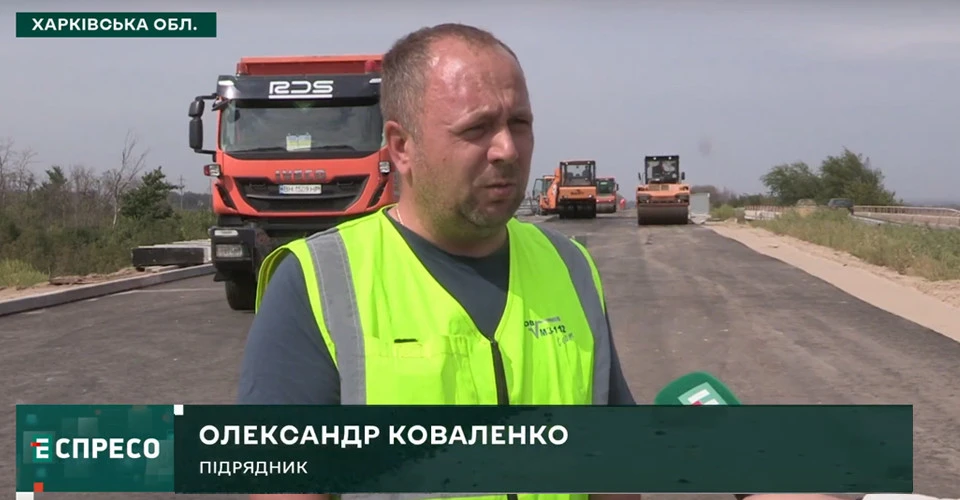
Rebuilding Kharkiv region: damage scope and main challenges of recovery
In 2022, the occupying Russian forces seized half of the Kharkiv region. The Defense Forces of Ukraine managed to drive them out, but the fighting destroyed all key logistics routes, especially bridges
A special episode of the Urban Reconstruction and Development Program on Espreso features this information.
The transportation network was completely paralyzed. The damage was estimated at UAH 8 billion.
The Infrastructure Recovery and Development Service emphasizes that rebuilding bridges is not a luxury, but a necessity. Some of them are key not only for civilian but also for military logistics. At the same time, restoring bridges is quite dangerous, especially in the area of active hostilities.
“Where we have been working at the sites, we have repeatedly been hit - either nearby or in the artificial structure itself. Where people, road builders and construction workers were working. As a result, work was suspended for some time at some facilities, and some have been completely stopped,” Vyacheslav Nazarenko, Deputy Head of the Kharkiv Region Recovery Service, told reporters.

It is because of the threat of repeated shelling that the service cannot publicly announce which bridges have already been restored and which are in the process of being rebuilt.
In addition, after the liberation, some bridges were mined.
Currently, 17 bridges are being repaired. At the same time, 10 of them are expected to be put into operation by the end of this year.
Tetyana Melnyk, an expert on municipal infrastructure restoration at the Association of Ukrainian Cities, told Espreso about the reconstruction of Kharkiv region.
Amount of damage
According to her, financial losses in the field of transport infrastructure are extremely large. According to the rating of all the losses caused to Ukraine by the armed aggression of the Russian Federation, they are in second place, accounting for about 20% of all direct losses. As of the end of 2023, this amounted to about $37 billion.
“The first place in terms of infrastructure destruction is residential infrastructure, and these are very significant losses, accounting for almost 40% of the total,” the expert said, adding that the losses amount to about UAH 3 trillion.

“As for the social infrastructure facilities in the territorial communities, 3,800 educational institutions were damaged, and there are also destroyed facilities, and such losses amount to about 5%. But today we understand that in 2024, during these more than eight months, new destruction of housing and energy infrastructure has taken place, which will also add to the scope and, possibly, change the proportions of these losses somewhere,” added Tetyana Melnyk.
According to her, Ukraine has now built a recovery planning system, the legislation provides for several documents that local governments, in particular, must develop in order to plan repair work, analyze what needs to be restored and what does not, which projects are prioritized and which can be implemented later.
Main obstacle in reconstruction process
The main obstacle in the reconstruction process is the lack of funding.
“There is a recovery plan, but there is no clear source of funding for it. Of course, local governments approve programs from their local budgets, provide funding for urgent needs, including housing, and for the reconstruction of some buildings, if these budgets are capable and have such funds. Therefore, the issue of local budgets being able to continue to allocate money for reconstruction next year is extremely important,” the expert emphasized.
She noted that the state budget for 2025 proposes to allocate up to UAH 1 billion for housing reconstruction under two state programs.
“But if we are talking about the need for more than three trillion, and this is as of the end of 2023, we understand that such losses have increased significantly this year and these funds will not be enough, other sources are also needed,” said Tetyana Melnyk.

Answering the question of how to determine the facility to be rebuilt in the first place, the expert said that this is spelled out in the territorial community recovery plan.
“Of course, there are some sectoral priorities at the ministry level, where they determine which facilities are more important. But firstly, a community recovery plan should be drawn up, which should prioritize the reconstruction of facilities,” explained Melnyk.
At the same time, local communities are still waiting for the list of recovery areas to be approved at the central level, as the criteria for determining such areas were approved in 2023 and then underwent some changes.
“We are now waiting for the list of recovery areas to be officially approved by a government decision, and the speed of developing recovery plans also depends on this,” the expert said.
Other challenges of recovery
“In general, such challenges are primarily related to the armed aggression itself, to the destruction of infrastructure. But not only, because the infrastructure was inadequate even before the armed aggression, I mean, outdated equipment, outdated production, non-inclusive infrastructure in some institutions, it also needs to be updated and special approaches. In addition, today there are certain new standards, new requirements for various infrastructure facilities, and this should be taken into account when rebuilding,” said Tetyana Melnyk.

“Other challenges are, of course, the damage caused to nature, the nature reserve fund, and the destroyed forests, which have significantly increased greenhouse gas emissions,” she added.
According to her, there are also challenges related to migration, both within the country and abroad. Therefore, it is important to adopt a demographic strategy at the state level that will define the tasks and measures necessary to return people to their communities, the expert emphasized.
In addition, Ukraine has significant educational losses due to the fact that students have been studying remotely for a long time, the quality of education has declined, and many are not able to get an education at all. Therefore, the state is faced with the task of creating safe learning conditions for children, including through the construction of air raid shelters.
Why roads and bridges are important
According to Tetyana Melnyk, logistics is no less important than housing reconstruction.
“First of all, the road allows us to deliver humanitarian aid, provide some urgent support, in some cases it is an evacuation of the population. We understand that there are frontline communities where it is necessary to be able to evacuate citizens. Of course, this means organizing and ensuring the defense of those settlements that are close to the front line,” the expert explained.

Time needed to restore infrastructure
According to the Association of Ukrainian Cities representative, the course of repair work depends on many factors.
“Unfortunately, it is impossible to say for sure, as it depends on many factors: the amount of funding, how quickly these funds will be provided, how efficiently all procedures will be carried out, and how much labor there will be for construction,” said Melnyk.
“There are certain problems with the fact that a lot of workers and materials are needed, and it is necessary to organize and find such resources, not only financial, but also human and logistical,” she added.
- News












































